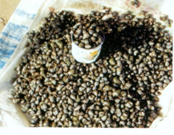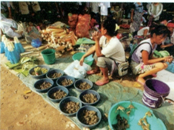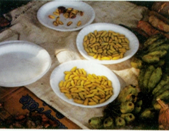Food Consumption Patterns of North Eastern Communities
The Traditional Kitchen The traditional kitchen of tribal people in North-East India is in nature. Most of the tribes use earthen stoves for cooking their food. The wood and dried leaves collected from forest are used as fuel. The stove is mostly placed in the central place of the kitchen. A square or rectangular wooden structure made of two to three frames in different levels is hanging from the roof. On this structure, the semi- processed foods items such as dried taro leaves, petioles and tubers, mustard leaves, maize cobs, dried fish and meat, pork fat etc are tied and handed. The smoke emits from the stove passes through the preserved products before entering outside. The smoke helps these products to maintain quality and also prevent pest and disease attack thereby extending their shelf-life. A typical traditional kitchen of Konyak tribes of Nagaland is given in
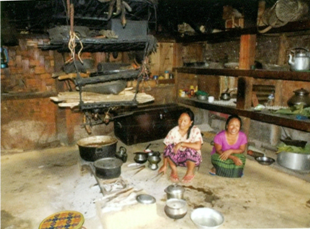 |
| Tradition Naga kitchen with preserved crop and animal products |
Eating pattern and variety of foods consumed
The food consumption pattern of North-East Indian communities depend on the sun rise pattern and season. The NE people eat food three times a day, first one being the breakfast at 5-6 AM, while the lunch is consumed during 10-11 AM. The dinner is often completed during 5-6 PM. A typical meal includes a cereal i.e. rice or millets, vegetable (mixture of vegetables, fermented soybean/fish added, flavoured by local spices), meat (mostly pork bird meat) with local spices. The most popular class of rice is the Joha or scented rice. As a staple diet rice is eaten either steam boiled (ukhua) or sundried (aaroi). Other rice varieties like bora (sticky rice, for their own consumption in various preparation), malbhog, chakoa, etc are also being consumed. Several nutritious rice-based preparations and brew, called apong, zu in Arunachal Pradesh, sa, laopani, haria in Assam, kakiad in Meghalaya, madhu in Nagaland etc. consumed in hill areas and also in the plains of Assam (Ngachan etal., 2012). The Maring tribes of Manipur are fond of spicy and hot food. Processed fermented soyabeans known as ‘bethao bebung’ is a part of almost every meal of Maring family. Marings are also fond of rice beer (Wai-tull) and puffing Pipe/Hukah (hilhaksu-hoktang tungka) in the past (Hou ran online, 2013) Among meat, pork, beef, mutton, chicken, duck, pigeon, squab etc are consumed. The Naga tribes also eat dogs, fish, spiders, birds, crabs, maggots and almost any living thing. Some of these items sold in the markets are shown in Fig. 2a. Big fishes are Rohu, Hilsa, Chital, Khoria as well as small fishes are Puthi, Borolia, Mua, cheniputhi, tengera, lachin, bhagun, pabho etc are consumed in NE states.
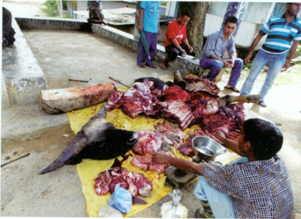 |
| Mithun meat sales at Nagaland |
Generally, tribal cuisine is prepared with less oil and exotic spices with strong flavours. Naga Chillies (Nagaland), Bird’s Eye Chilllies (Mizoram) and Lakadong Turmeric (Meghalaya) are famous local spices which have entered commercial markets outside NEH Region too. In Arunachal Pradesh, Meghalaya, and Nagaland, the large population prefers pork meat cooked with wild mushrooms or bamboo shoots. The Mizos (Mizoram) and the Nagas (Nagaland) are fond of all kinds of meat. The NEH people like vegetables and the strong flavor of exotic herbs. Bamboo-shoot delicacies are extremely popular. Among beverages, fermented rice, millet beer and black tea are considered delicacies by the NEH tribes.
Popular foods of North-East India
Some popular foods of North-East India are (i) Assam: Maasor Tenga, Pitha (ii) Arunachal Pradesh : Dung Po (Steam Rice), Wungwut Ngam (Chicken with rice powder), Pasa (Soup) and Apong (Beer), (iii) Manipur: Iromba, Kabok< Chakkouba, and Shingzu (iv) Meghalaya: Jastem (rice with pork), Mylliem chicken, Pukhlein Jadoh, Kyat (Beer), (v) Mizoram : Morok metpa, Cham thong, Zu (Tea), (vi) Nagaland : Momos, Rice beer, Cherry wine and (vii) Tripura : Chakhwi, Mwkhwi, Muitru.
Tuber crops consumption patterns
While rice and millets are consumed throughout the year, maize consumption is restricted to June – October every year. Though tuber crops are consumed throughout the year in both fresh and processed form, their consumption is higher during lean season (July-September).
Among tubers, taro is widely consumed in both fresh and processed form. Many tribes consume the tender leaves, shoots, petioles, mother corms and cormels of taro and prepare a variety of dishes from them. Some important taro landraces that are preferred by Konyak Nagas for consumption are listed in Table 1.
Table 1:Taro landraces preferred by Konyak Nagas in Nagaland
| Taro landrace |
Young unfolded leaf |
Young leaf |
Matured fresh leaf |
Matured dryleaf |
Young petiole |
Matured petiole |
Mother corm |
Cormels |
| Balsan |
Y |
- |
- |
Y |
Y |
_ |
Y |
Y |
| Balkedoh |
Y |
- |
- |
Y |
Y |
- |
Y |
Y |
| Nalon |
Y |
Y |
Y |
Y |
Y |
Y |
Y |
Y |
| Kungnyak |
Y |
- |
- |
- |
- |
- |
Y |
Y |
| Baishi |
- |
- |
- |
- |
- |
- |
Y |
Y |
| Pungmathung |
- |
- |
- |
- |
Y |
- |
Y |
Y |
| Lama |
Y |
- |
Y |
- |
- |
- |
Y |
Y |
| Thungkho |
Y |
- |
Y |
- |
- |
- |
Y |
Y |
| Tungcho |
Y |
Y |
Y |
- |
Y |
Y |
Y |
Y |
| Tungphum |
Y |
- |
Y |
- |
- |
- |
Y |
Y |
| Tungtho |
Y |
- |
Y |
- |
- |
- |
Y |
Y |
| Toasa |
Y |
Y |
Y |
Y |
Y |
Y |
Y |
Y |
| Toasum |
- |
- |
- |
- |
- |
- |
Y |
Y |
| Zazon |
- |
- |
- |
- |
- |
- |
Y |
Y |
*Y denotes the preference of the landrace
Semi-processed taro leaf products like Teangyakwan (Anishi), teangwan and teangkhoi are prepared during harvest season and consumed throughout the year, Dried taro products are stored in bamboo baskets or cloth bags that are tied in a wooden structure placed above the earthen stove in the kitchen (fig.1). The heat and smoke emerged during cooking prevent the spoilage of these products.
Tuber crops in food and nutritional security
Tuber crops play a crucial role in the food and nutritional security of NEH tribes. In general, food security is defined as the state at which all people, at all times, have physical and economic access to sufficient, safe, and nutritious food to meet their dietary needs and food preferences for an active and healthy life (World Food Programme, 2009). Bestowed with abilities of high dry matter content, ability to adapt to soil and climatic conditions and high storability in the semi-processedd form, these crops serve as “secondary staples” in tribal areas. Tuber crops are popular secondary staples among NEH tribes that are consumed especially during lean season. Tubers are the major component of tribal diet during lean season which cater to their energy and nutrient needs thereby providing food and nutritional security. Specific mechanisms through which tuber crops contribute to food and nutritional security identified through Focus Group Discussions is discussed below:
1. Stomach fillers
Tribes consume the boiled tubers (fresh or dried) of taro or sweet potato in the early morning and evening along with black tea. These boiled tubers provide instant energy and also reduce the quantity of rice consumed during break-fast or dinner. Since the boiled tubers are slowly digested, they provide the energy for carrying out agricultural operations and keep them active for 3-4 hours.
2. Vegetable replacers
The tribal diet consists of fresh plant parts and semi-processed products from tuber crops. During cropping season, they consume the taro tender leaves, shoots and petioles while the semi-processed products are eaten during lean season. Semi-processed products can be stored for 10 months without spoilage and are consumed when other vegetables are costly or not available. As vegetable substitutes, they supply essential nutrients at cheaper cost.
3. Supplementary income sources
Though tuber crops are cultivated mostly for home consumption, some tribes are also following market-oriented tuber crops cultivation. The marketable surplus is sold in the market to generate supplementary income to meet the food needs during lean season. They also cut the self-grown cassava, taro and sweet potato, and sell them as pig feed in the market. The harvesting of self-grown plants for animal food in Nagaland is given in Fig.3. The income generated through the sales is used to meet the food and nutritional needs of the lean season.
Thus, tuber crops are considered as “food and nutritional security crops” that supply carbohydrate and micronutrients in both cropping and lean seasons.
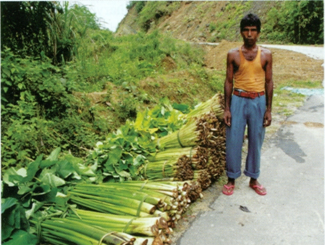 |
| Self –grown taro collected from forest is utilized as animal feed |
Source:
Traditional Tuber Crops of North-Eastern India
Dr.P. SethuramanbSivakumar, et.al
Central Tuber Crops Research Institute (CTCRI)
Sreekariyam, Thiruvanathapuram
Kerala
|



